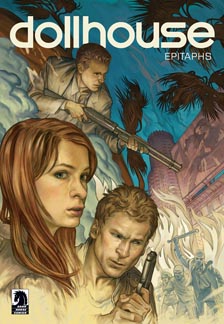On the Season 2 DVD, Joss Whedon says “Dollhouse” was a pebble he could’ve turned over for as much as seven seasons. Unfortunately, we only got 26 episodes, but “Epitaphs” (2011-12) – a six-issue comic book series from Dark Horse – turns over the pebble of this great concept a little bit more.
In essays about the show (I recommend “Inside Joss’ Dollhouse: From Alpha to Rossum”), the episodes “Epitaph One” and “Epitaph Two: Return” are mentioned an inordinate amount. This because they conclude the saga’s storyline, jumping ahead a decade to show an apocalypse where most of humanity has been mind-wiped into Dumbshows or mind-controlled into violent Butchers by the twisted Rossum Corporation.
Although I liked those episodes a lot more on my recent rewatch, they left me cold when they first aired, and they still kind of do. This is a function of the fact that there’s a decade of missing story after “The Hollow Men,” the conclusive “present day” episode of the series. “Epitaphs” fills in that gap, and it’s by husband-and-wife “Dollhouse” staff writers Jed Whedon and Maurissa Tancharden (along with Andrew Chambliss), so it’s safe to say the story came from ideas that would’ve been thrown around in the writers’ room if the show had continued. Indeed, this storyline may have been discussed anyway, just so the “Epitaph” episodes would have a solid backstory.
Although I sometimes think “epitaph” means “epilogue,” it of course refers to words written on a gravestone. As with the episodes that have this title, the heroes in “Epitaphs” are surrounded by death. The innocent Dumbshows are being killed by Butchers. There are also Wielders, people who go around imprinting people as Butchers. All of these groups spring from Rossum’s twisted tech. A lot of the plot deals with the back-and-forth of Rossum finding a way to imprint people and our heroes shutting that down, then Rossum coming up with a new strategy, and so forth.
The interesting pebble-turning is the character stuff, though. In “Epitaphs,” we learn how Alpha became good. It happens seemingly overnight on the show; it’s a process here. Partly influenced by an imprint of Ballard, partly because his true self is gaining control of his evil selves, he fights the good fight. Intriguingly, the good Alpha is able to do so thanks to a compromise with his evil selves, whom he lets loose at times, but only against Butchers.
One of the show’s missed opportunities was digging into multiple imprints of the same person interacting with each other. We did get Topher talking on the phone to “himself” (an imprinted Victor) once, but “Epitaphs” goes further through the character(s) of Ivy. Played by Liza Lapira, Ivy was Topher’s assistant; it always seemed like the writers had more planned for her — some fans still theorize she was Ballard’s secret contact within the Dollhouse in Season 1, some theorized she was a doll like Dr. Saunders. As it turned out, Topher told her to leave when things heated up late in Season 2. The comic tells us she went to the Toyko Dollhouse.

Although Ivy 1.0 isn’t in “Epitaphs,” three imprinted versions of her are: a hot woman, a plump woman and a man. Entertaining scenes find the Ivies sexually experimenting with each other, which in and of itself is a commentary either on Ivy’s self-love or the concept that we’re drawn to people with common interests. The plot (or characterization, as it were) thickens: The male Ivy is attracted to the hot Ivy but not the plump version. (S)he admits that the male hormones have affected her decision-making. We saw in the series that the soul (metaphorical on “Dollhouse,” unlike in the Buffyverse) – the truest self — is linked to the body, whereas imprinted minds are not. But the Ivy arc in the comic is gives a fresh angle, because it shows the impact of the body’s automatic functions on the mind. The body trumps an imprinted mind in “Dollhouse.”
The action of “Epitaphs” bounces back and forth between two groups: One features Alpha, some Ivies and a new character, a Tech-Head (people who can retain a sense of self but can swap out implants) named Trevor. The other group features Mag and Zone, whom we had only known from the “Epitaph” episodes. Ballard and Echo only pop up late in the game. There’s no sign of Victor, Sierra, Topher or DeWitt, even though they are alive during this time (a note at the back of the trade paperback says DeWitt was in an early draft). Trevor is given such weight in the story that I’m guessing Jed Whedon and Tancharden had more story to tell but the series just didn’t sell well enough.
Nonetheless, “Dollhouse” fans will want to pick up the trade paperback to get a fuller picture of how the thoughtpocalypse came about and how Alpha became good, while also seeing that pebble turned over a few more times.

